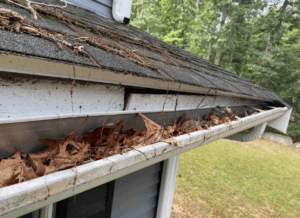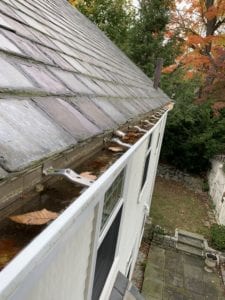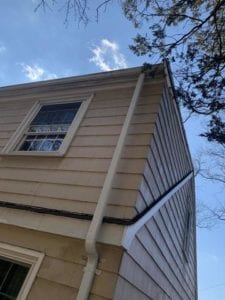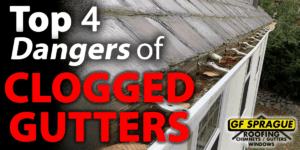 Just like us, roofs need an effective route to eliminate water and debris. While rainwater can be collected in your gutters and downspouts, if they are filled with leaves or debris, there is a high chance that the water in your gutters will become blocked and will not be properly distributed away from your home. For this reason, every roofing system needs to have gutters and downspouts that are properly working, guiding ice, rain, snow, leaves, and debris away from your home. When gutters become clogged, your whole home will feel the effects. In some cases, clogged gutters are the inevitable result of autumn weather. Falling leaves can sometimes be unavoidable and you may need to phone your local roofing contractor to do a proper cleaning. If your gutters remain clogged for long periods of time, it can result in water leaks and even damage the structural integrity of your home’s foundation! Here’s a list of the top risks that a clogged gutter can pose to your home and the solutions to prevent leaks and/or high levels of clogging.
Just like us, roofs need an effective route to eliminate water and debris. While rainwater can be collected in your gutters and downspouts, if they are filled with leaves or debris, there is a high chance that the water in your gutters will become blocked and will not be properly distributed away from your home. For this reason, every roofing system needs to have gutters and downspouts that are properly working, guiding ice, rain, snow, leaves, and debris away from your home. When gutters become clogged, your whole home will feel the effects. In some cases, clogged gutters are the inevitable result of autumn weather. Falling leaves can sometimes be unavoidable and you may need to phone your local roofing contractor to do a proper cleaning. If your gutters remain clogged for long periods of time, it can result in water leaks and even damage the structural integrity of your home’s foundation! Here’s a list of the top risks that a clogged gutter can pose to your home and the solutions to prevent leaks and/or high levels of clogging.
-
Roof Damage from Clogged Gutters
- Clogged gutters prevent water from effectively directing itself towards downspouts and away from the roof. Any obstructions cause water to pool in gutters and surrounding materials such as fascia boards, shingles, and siding will begin to rot and deteriorate. It could end up in you requiring a roof replacement. In addition, if water begins pooling on the roof, this can result in leaks and subsequently, mold or mildew growth. If you are a homeowner with wooden gutters, there is an increased chance of rotting and structural damage because when the leaves and debris decompose, the natural wood will follow suit. Homeowners with vinyl gutters will also feel the effects of clogged gutters. When gutters become filled with debris, water can more easily reach the fascia board resting behind the gutters. Overflowed water can then enter through the fascia boards into your home. Compared to gutters such as aluminum, copper, and lead-coated copper, these smaller, more flimsy types of gutters are more vulnerable to the risks of clogged gutters.
-
Basement Flooding
- Functioning gutters and downspouts divert water away from your roof and the radius of your home. When gutters become clogged and water isn’t effectively removed, it will begin to pool around the foundation of your home. This can lead to water damage, basement flooding, mold growth, and structural instability. With proper downspouts and gutters that are large enough to handle leaves and debris, this situation can be avoided. With smaller gutters, water can pour over the edges, completely avoiding the route to the downspouts, and go directly into the edges of your basement. The last thing you need is the foundation of your home cracking and deteriorating from water damage.
-
Increased Chance of Ice Dams from clogged gutters

- One of the top causes of ice dams is a clogged gutter! In a properly functioning roofing system, melted snow will enter those gutters and be directed away from the home. Gutters that are smaller pose a greater risk of ice dams. When they are clogged with debris, that water from the melted snow cannot move freely and sits in your gutters. After a freeze-thaw cycle, the melted snow will now freeze in your gutters and lead to an ice dam. In colder climates, ice dams form when water or melted snow around the edge of your roof is improperly eliminated and freeze. Water that is pooled in clogged gutters will freeze and lead to ice dams.
-
Damage to Driveways and Sidewalks
- With poor drainage from clogged gutters, water frequently ends up on driveways and walkways and seeps into the ground nearby. When water expands underneath or next to concrete, it can cause cracking. This not only damages the integrity but becomes a safety hazard for any individuals walking close by. Melted snow that pours over your gutters will reach your pathways and driveway. A frozen driveway caused by clogged gutters is a safety hazard for family members.
Solutions to Prevent and Repair Clogged Gutters
-
Clean your gutters!
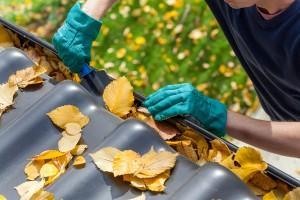
- The first step a homeowner can take in preventing clogged gutters is to clean them! Hiring a local roofing contractor is the top choice for leaf and debris removal. But if you are a DIY homeowner and are looking to complete the task on your own, then be sure to follow safety precautions.
- Make sure you have a sturdy and extendable ladder. Make sure to always place that ladder onto a sturdy surface near your gutters. Using a ladder stabilizer can help prevent damage to your gutters. If you have vinyl gutters, do not rest your ladder on them.
- Wear clothes that you aren’t worried about damaging. Cleaning gutters is a dirty job so wearing sturdy shoes and tough clothing can prevent any falls or clothing damage.
- Place a tarp beneath your gutters to collect all falling debris.
- Use a plastic scoop to remove leaves and debris from your gutters. Anything from a kitchen spatula or a toy shovel can work in this scenario.
- Once all debris is removed from your previously clogged gutters, take a garden hose and rinse down any last spots.
- After the gutter cleaning is complete, make sure to check if all metal parts are sturdy and that they haven’t been loosened from the weight of wet leaves and debris.
- The first step a homeowner can take in preventing clogged gutters is to clean them! Hiring a local roofing contractor is the top choice for leaf and debris removal. But if you are a DIY homeowner and are looking to complete the task on your own, then be sure to follow safety precautions.
-
Invest in larger, sturdier gutters
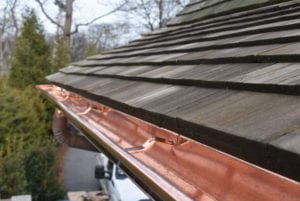
- If you think your frequent clogged gutters may be due to the gutters themselves, then it may be time for a replacement. Compared to copper, lead-coated, aluminum, and zinc alloy gutters; wooden and vinyl gutters are on the smaller side and can lead to a quicker and more frequent build-up of debris. Do a quick research on different gutter options and find a quote from a local roofing contractor. Researching the different types of gutters and which one is right for you, is essential in ensuring that your roofing system is functioning properly.
-
Check out your downspouts!
- If you are experiencing frequent gutter clogging, it may be due to your downspouts being misshapen or misaligned with your gutters. Call a local roofing contractor to see if they can come out and inspect your gutter and downspouts to see if there is anything preventing water or debris from being distributed away from your home.
If you think your gutters are clogged, the first step you can take is to call a certified roofer to come out and inspect your home. The worst thing you could do is leave your gutters alone.
